Burden of cancer attributable to excess bodyweight and physical inactivity in Japan in 2015
Hirabayashi M, Abe SK, Sawada N, Saito E, Hori M, Katanoda K, Matsuda T, Inoue M; the Cancer PAF Japan Collaborators
Overweight and obesity are known contributors to many non-communicable diseases, including cancer, and affect over one-tenth of the global population. One way to maintain a healthy weight and reduce the risk for cancer is through increased physical activity. We estimated the fraction of cancer incidence and mortality in 2015 attributable to excess bodyweight as well as lack of physical activity among the Japanese population. The optimal body-mass index (BMI) for the purposes of this study was determined to be less than 23 kg/m2. Mean BMI for each sex and age group was calculated using measured weight and height data extracted from the 2005 Japanese National Health and Nutrition Survey (JNHNS). For the data on physical activity, we extracted the answers from the same survey from a question regarding whether the respondent did regular exercise. Population attributable fractions (PAFs) for each cancer positively associated with excess bodyweight - esophageal adenocarcinoma, stomach (cardia), colorectum, liver, gallbladder, pancreas, female breast (pre- and post- menopausal), ovary, endometrium, advanced prostate and kidney - and for those positively associated with physical inactivity - colorectum, female breast and endometrium - were calculated for each sex and age group and aggregated to obtain the PAF among total cancer incidence and mortality. Excess bodyweight was attributable to 0.7% of cancer incidence and mortality, while lack of regular exercise was attributable to 1.3% of cancer incidence and 0.8% of cancer mortality. Around 1% of cancer incidence and mortality in Japan in 2015 are attributable to excess bodyweight and physical inactivity.







